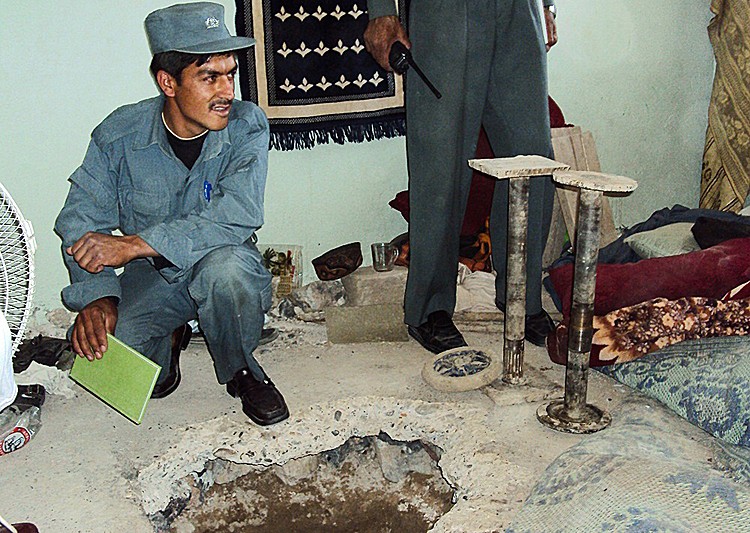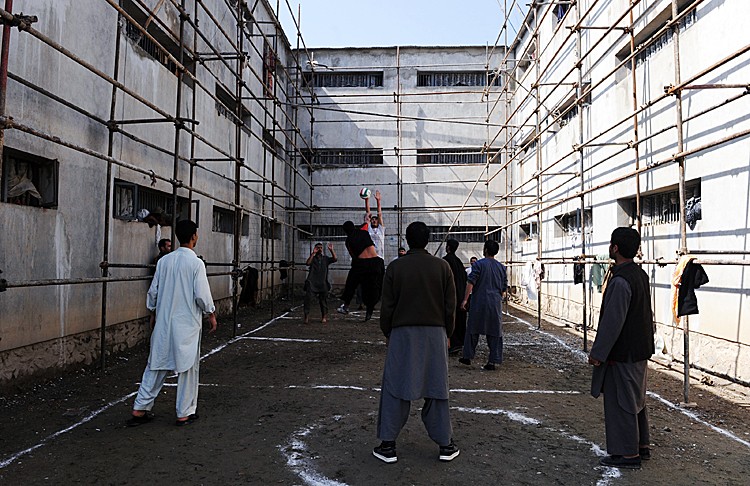Cell Block 3 was in flames as prison riots continued in the next block over. The Taliban had grown too powerful, and the confinements of Afghanistan’s Pol-e-charki prison became little more than protective walls rendering them untouchable from the war raging outside.
The December 2008 riots at Pol-e-charki prison on the outskirts of Kabul served as a wake-up call to the severity of the corruption that had crept in through padded pockets and turning blind eyes. Captured Taliban commanders and radicalized prisoners had formed an operating center within Cell Block 3—armed with weapons, and with their own Shura Council to hold trials, vote, and eliminate those who refused to cooperate.
“The guards were not even allowed to go down into the cell block because they would be killed or kidnapped—I mean, its the Wild West out there,” said Drew Berquist, a former U.S. intelligence agent and author of “The Maverick Experiment,” in a phone interview.
Attention fell on the prison after the riots, and rebuilding efforts became focused on increasing security. This included eliminating cells for large groups, and replacing them with cells for smaller groups of between two and eight.
The December 2008 riots at Pol-e-charki prison on the outskirts of Kabul served as a wake-up call to the severity of the corruption that had crept in through padded pockets and turning blind eyes. Captured Taliban commanders and radicalized prisoners had formed an operating center within Cell Block 3—armed with weapons, and with their own Shura Council to hold trials, vote, and eliminate those who refused to cooperate.
“The guards were not even allowed to go down into the cell block because they would be killed or kidnapped—I mean, its the Wild West out there,” said Drew Berquist, a former U.S. intelligence agent and author of “The Maverick Experiment,” in a phone interview.
Attention fell on the prison after the riots, and rebuilding efforts became focused on increasing security. This included eliminating cells for large groups, and replacing them with cells for smaller groups of between two and eight.
“You had a prison that was run by the Afghan government, but really, entire facilities within that prison were being used as training and education grounds for insurgent elements,” said Drew Quinn, Bureau of International Narcotics and Law Enforcement Affairs director at the U.S. Embassy Kabul, on the NATO Channel in Nov. 2009.
Resolving such issues is no simple matter, and the battle behind prison walls continues to this day.
A rare news conference in Kabul, held by Afghanistan’s National Directorate of Security intelligence service in February, highlighted the breadth of the problem—noting that despite efforts to root out operations at Pul-e-Charkhi, it is still going strong.
Taliban commander Talib Jan, a prisoner at Pul-e-Charkhi, is one of the more extreme cases. He organizes suicide bombings across Kabul from within his cell—including the Jan. 28 suicide bombing of a supermarket that killed 14 people.
“Most of the terrorist and suicide attacks in Kabul were planned from inside this prison by this man,” said National Directorate of Security spokesman, Lutfullah Mashal, at the conference, New York Times reported.
The problem, according to Berquist, runs deep.
“The prison systems are corrupt,” Berquist said. “The safest place for the Taliban is the prisons because they can’t get caught again.”
Resolving such issues is no simple matter, and the battle behind prison walls continues to this day.
A rare news conference in Kabul, held by Afghanistan’s National Directorate of Security intelligence service in February, highlighted the breadth of the problem—noting that despite efforts to root out operations at Pul-e-Charkhi, it is still going strong.
Taliban commander Talib Jan, a prisoner at Pul-e-Charkhi, is one of the more extreme cases. He organizes suicide bombings across Kabul from within his cell—including the Jan. 28 suicide bombing of a supermarket that killed 14 people.
“Most of the terrorist and suicide attacks in Kabul were planned from inside this prison by this man,” said National Directorate of Security spokesman, Lutfullah Mashal, at the conference, New York Times reported.
The problem, according to Berquist, runs deep.
“The prison systems are corrupt,” Berquist said. “The safest place for the Taliban is the prisons because they can’t get caught again.”
Prisoners often use cell phones to communicate with, and give commands to, insurgents operating outside. Meanwhile, since captured Taliban and al-Qaeda leaders from across the country are at times detained together, the prisons give them an otherwise nonexistent opportunity to network and coordinate—since they are wary of gathering too many leaders in one place outside the prisons for fear of attack by unmanned aerial vehicles (UAVs) or special operations raids.
“The culture becomes so tough to break because these guys become so powerful within the prison,” Berquist said, adding that when they try to dismantle networks by moving prisoners to different cells, “they meet additional people and all it does is end up expanding things.”
“The culture becomes so tough to break because these guys become so powerful within the prison,” Berquist said, adding that when they try to dismantle networks by moving prisoners to different cells, “they meet additional people and all it does is end up expanding things.”
Read more on Afghan Prisons Becoming Taliban Bases . . .
A Corrupt System
Pol-e-charki is haunted by significant infamy, even for Afghanistan—its Soviet past of violence, terror, and political turmoil has been reanimated to face a new war. Impassible roads through communities supportive of the insurgents lead to its gates, while the now empty mass graves of political prisoners nearby stand as painful reminders of the prison’s Soviet founders in the late 1970s.
The problem is not limited to Pol-e-charki, however, as other Afghan prisons have met with similar problems.
The April 25 Taliban “Great Escape” at Saraposa prison in Kandahar dealt a blow to the image of Afghan prison security, when 500 inmates escaped through a 1,000-foot-long tunnel, and with the help of corrupt guards.
The incident happened after Saraposa was revamped, similar to Pol-e-charki, after a 2008 attack on the prison that freed 900 inmates in broad daylight. The whole area was known for corruption, with “assassinations of investigators, bribery of prosecutors, intimidation of justices, and attacks upon witnesses” that “obscured both evidence and law,” stated Army Brig. Gen. Mark Martins in a Feb. 10 Department of Defense video conference, according to the Pentagon transcript.
Illegal use of cell phones by prisoners is one of the key problems, since they act as enablers for commanding troops outside, and efforts to take their phones have met with little success. “Most of them operate either with their own phones smuggled in, or they pay corrupt guards to use their phones to call not just people inside the prison, but also to other people in Afghanistan, and across the border into Pakistan,” Berquist said.
The problem is not limited to Pol-e-charki, however, as other Afghan prisons have met with similar problems.
The April 25 Taliban “Great Escape” at Saraposa prison in Kandahar dealt a blow to the image of Afghan prison security, when 500 inmates escaped through a 1,000-foot-long tunnel, and with the help of corrupt guards.
The incident happened after Saraposa was revamped, similar to Pol-e-charki, after a 2008 attack on the prison that freed 900 inmates in broad daylight. The whole area was known for corruption, with “assassinations of investigators, bribery of prosecutors, intimidation of justices, and attacks upon witnesses” that “obscured both evidence and law,” stated Army Brig. Gen. Mark Martins in a Feb. 10 Department of Defense video conference, according to the Pentagon transcript.
Illegal use of cell phones by prisoners is one of the key problems, since they act as enablers for commanding troops outside, and efforts to take their phones have met with little success. “Most of them operate either with their own phones smuggled in, or they pay corrupt guards to use their phones to call not just people inside the prison, but also to other people in Afghanistan, and across the border into Pakistan,” Berquist said.
Meanwhile, non-insurgents going into the prisons can be thrown into a cycle of radicalization through Taliban and al-Qaeda members inside. Prisoners arrested for more extreme crimes also rarely serve their full sentences, which becomes a problem since “they start to get street cred having been in prison, when they get out,” Berquist said, “You get guys who become more extreme in prison then come out as a much bigger problem than when they went in.”
He added that, “because of how corrupt the system is, people frequently do get out because there are a lot of dirty parliamentarians and other government officials who take bribes.”
The flow of corruption into Afghan prisons is difficult to put a cap on.
“If you didn’t go in dirty there’s a reasonable chance you’re going to turn dirty because you’re going to get frustrated by how monotonous and how difficult it is to be in those positions, and just how tough life is there,” Berquist said. “Eventually that money starts to sound good, and it’s a slippery slope once you do that.”
He added that, “because of how corrupt the system is, people frequently do get out because there are a lot of dirty parliamentarians and other government officials who take bribes.”
The flow of corruption into Afghan prisons is difficult to put a cap on.
“If you didn’t go in dirty there’s a reasonable chance you’re going to turn dirty because you’re going to get frustrated by how monotonous and how difficult it is to be in those positions, and just how tough life is there,” Berquist said. “Eventually that money starts to sound good, and it’s a slippery slope once you do that.”









![[LIVE Q&A 04/30 at 10:30AM ET] INTERPOL Used by CCP for Global Repression | Live With Josh](/_next/image?url=https%3A%2F%2Fimg.theepochtimes.com%2Fassets%2Fuploads%2F2025%2F04%2F29%2Fid5849815-043025_REC-1080x720.jpg&w=1200&q=75)


